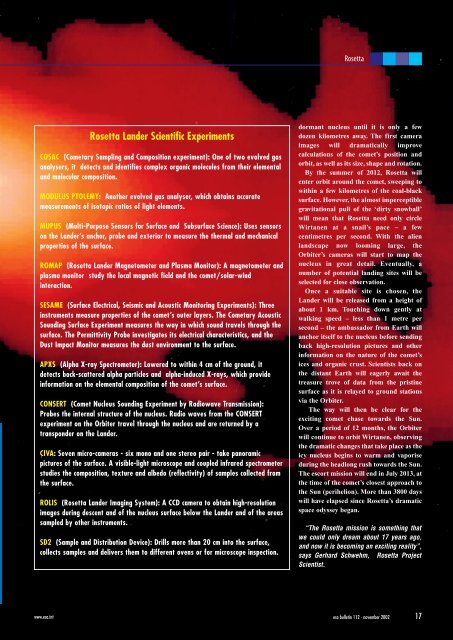Why 'Rosetta'? - ESA
Why 'Rosetta'? - ESA
Why 'Rosetta'? - ESA
You also want an ePaper? Increase the reach of your titles
YUMPU automatically turns print PDFs into web optimized ePapers that Google loves.
Rosetta Lander Scientific Experiments<br />
COSAC (Cometary Sampling and Composition experiment): One of two evolved gas<br />
analysers, it detects and identifies complex organic molecules from their elemental<br />
and molecular composition.<br />
MODULUS PTOLEMY: Another evolved gas analyser, which obtains accurate<br />
measurements of isotopic ratios of light elements.<br />
MUPUS (Multi-Purpose Sensors for Surface and Subsurface Science): Uses sensors<br />
on the Lander’s anchor, probe and exterior to measure the thermal and mechanical<br />
properties of the surface.<br />
ROMAP (Rosetta Lander Magnetometer and Plasma Monitor): A magnetometer and<br />
plasma monitor study the local magnetic field and the comet/solar-wind<br />
interaction.<br />
S<strong>ESA</strong>ME (Surface Electrical, Seismic and Acoustic Monitoring Experiments): Three<br />
instruments measure properties of the comet’s outer layers. The Cometary Acoustic<br />
Sounding Surface Experiment measures the way in which sound travels through the<br />
surface. The Permittivity Probe investigates its electrical characteristics, and the<br />
Dust Impact Monitor measures the dust environment to the surface.<br />
APXS (Alpha X-ray Spectrometer): Lowered to within 4 cm of the ground, it<br />
detects back-scattered alpha particles and alpha-induced X-rays, which provide<br />
information on the elemental composition of the comet’s surface.<br />
CONSERT (Comet Nucleus Sounding Experiment by Radiowave Transmission):<br />
Probes the internal structure of the nucleus. Radio waves from the CONSERT<br />
experiment on the Orbiter travel through the nucleus and are returned by a<br />
transponder on the Lander.<br />
ÇIVA: Seven micro-cameras - six mono and one stereo pair - take panoramic<br />
pictures of the surface. A visible-light microscope and coupled infrared spectrometer<br />
studies the composition, texture and albedo (reflectivity) of samples collected from<br />
the surface.<br />
ROLIS (Rosetta Lander Imaging System): A CCD camera to obtain high-resolution<br />
images during descent and of the nucleus surface below the Lander and of the areas<br />
sampled by other instruments.<br />
SD2 (Sample and Distribution Device): Drills more than 20 cm into the surface,<br />
collects samples and delivers them to different ovens or for microscope inspection.<br />
www.esa.int esa bulletin 112 - november 2002 17<br />
Rosetta<br />
dormant nucleus until it is only a few<br />
dozen kilometres away. The first camera<br />
images will dramatically improve<br />
calculations of the comet’s position and<br />
orbit, as well as its size, shape and rotation.<br />
By the summer of 2012, Rosetta will<br />
enter orbit around the comet, sweeping to<br />
within a few kilometres of the coal-black<br />
surface. However, the almost imperceptible<br />
gravitational pull of the ‘dirty snowball’<br />
will mean that Rosetta need only circle<br />
Wirtanen at a snail’s pace – a few<br />
centimetres per second. With the alien<br />
landscape now looming large, the<br />
Orbiter’s cameras will start to map the<br />
nucleus in great detail. Eventually, a<br />
number of potential landing sites will be<br />
selected for close observation.<br />
Once a suitable site is chosen, the<br />
Lander will be released from a height of<br />
about 1 km. Touching down gently at<br />
walking speed – less than 1 metre per<br />
second – the ambassador from Earth will<br />
anchor itself to the nucleus before sending<br />
back high-resolution pictures and other<br />
information on the nature of the comet’s<br />
ices and organic crust. Scientists back on<br />
the distant Earth will eagerly await the<br />
treasure trove of data from the pristine<br />
surface as it is relayed to ground stations<br />
via the Orbiter.<br />
The way will then be clear for the<br />
exciting comet chase towards the Sun.<br />
Over a period of 12 months, the Orbiter<br />
will continue to orbit Wirtanen, observing<br />
the dramatic changes that take place as the<br />
icy nucleus begins to warm and vaporise<br />
during the headlong rush towards the Sun.<br />
The escort mission will end in July 2013, at<br />
the time of the comet’s closest approach to<br />
the Sun (perihelion). More than 3800 days<br />
will have elapsed since Rosetta’s dramatic<br />
space odyssey began.<br />
“The Rosetta mission is something that<br />
we could only dream about 17 years ago,<br />
and now it is becoming an exciting reality”,<br />
says Gerhard Schwehm, Rosetta Project<br />
Scientist.
















